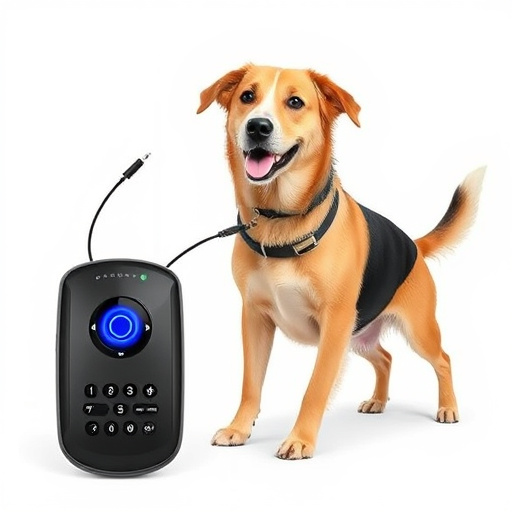Sonic dog training uses sound waves to correct behavioral issues like excessive barking or jumping by targeting specific dog-detectable frequencies, creating an unpleasant sensation without harm. Devices with Dog Repellent EMC Certification Requirements ensure safety and effectiveness in disrupting dogs' focus momentarily. This humane method combines sonic intervention with positive reinforcement for desired conduct. Adhering to EMC standards is vital for reliable products addressing canine behavioral issues through tailored sound wave frequencies. Continuous monitoring, adjustments, patience, and positive reinforcement are key to achieving effective results.
“Unleash a calm, well-behaved canine companion with the power of sonic dog training—a non-aggressive behavioral correction method. This innovative approach leverages sound waves as a gentle yet effective tool to modify your dog’s behavior.
From understanding the science behind ultrasonic sounds to selecting the ideal Dog Repellent with EMC Certification, this guide covers all aspects. Learn about the benefits and proper implementation techniques to ensure safe and successful training, transforming your dog’s behavior without causing harm.”
- Understanding Sonic Dog Training: A Non-Aggressive Approach
- The Science Behind Sound as a Behavioral Modifier
- EMC Certification: Ensuring Safe and Effective Devices
- Choosing the Right Sonic Repellent for Your Dog's Behavior
- Implementation and Monitoring: Tips for Successful Training
Understanding Sonic Dog Training: A Non-Aggressive Approach
Sonic dog training is a modern, non-aggressive approach to behavioral correction that utilizes sound waves to repel and correct unwanted behaviors. Unlike traditional punishment methods, it does not involve physical force or shock, making it a humane option for dog owners. This innovative technique leverages specific frequencies to create an unpleasant sensation in dogs without causing harm.
The technology behind sonic dog training involves devices with Dog Repellent EMC Certification Requirements, ensuring safety and effectiveness. These devices emit high-frequency sound waves that are below the human hearing range but can be detected by canines. When a dog exhibits unwanted behavior, such as barking excessively or jumping on furniture, the device emits a sound that momentarily disrupts their focus, immediately correcting the behavior without causing any lasting fear or distress. By combining this sonic intervention with positive reinforcement training methods, owners can guide their dogs towards more desirable behaviors.
The Science Behind Sound as a Behavioral Modifier
Sound has long been recognized as a powerful tool for modifying behavior, and its scientific application in dog training is no exception. The concept behind sonic dog training, often involving specific sound frequencies or ultrasonic devices, taps into the animal’s natural responses to auditory stimuli. Dogs, like many mammals, have a keen sense of hearing, and certain sounds can trigger immediate reactions, from startle response to behavioral changes.
The science behind this method is rooted in understanding the physiological effects of sound on the brain. Different frequencies can stimulate or suppress specific neural activities, which, when applied correctly, can influence a dog’s behavior. For instance, high-frequency ultrasonic sounds often used in dog repellents (a key aspect of EMC Certification Requirements for such devices) have been shown to deter unwanted behaviors without causing harm. This non-invasive approach makes it an appealing alternative to traditional correction methods, offering a more nuanced and precise way to shape canine behavior.
EMC Certification: Ensuring Safe and Effective Devices
When it comes to sonic dog training and behavioral correction devices, ensuring their safety and effectiveness is paramount. This is where EMC (Electromagnetic Compatibility) Certification plays a vital role. The EMC Certification process verifies that dog repellent devices meet strict international standards for electromagnetic interference (EMI). By adhering to these requirements, manufacturers ensure their products will function optimally while minimizing potential harm to both pets and humans.
The specific EMC Certification Requirements for Dog Repellent devices consider various frequency ranges and power levels. These standards guarantee that the sonic emissions from such devices are within safe limits, avoiding any adverse effects on a dog’s hearing or overall well-being. Moreover, they ensure these products won’t cause interference with other electronic devices in close proximity, making them reliable and hassle-free for users.
Choosing the Right Sonic Repellent for Your Dog's Behavior
When addressing behavioral issues in dogs, selecting the appropriate sonic repellent is key. It’s crucial to consider your dog’s specific behaviors and triggers before making a purchase. Different sonic devices emit distinct frequencies, designed to target specific behaviors like barking or jumping. For instance, low-frequency sounds can help deter barking, while higher pitches may be more effective for recall training.
Before settling on a product, ensure it meets EMC certification requirements, guaranteeing its safety and effectiveness. This standard confirms the device emits controlled sound waves within safe ranges for dogs. Additionally, review customer feedback to understand how well the repellent addresses various behaviors. Choosing the right tool tailored to your dog’s needs is essential for successful and humane behavioral correction.
Implementation and Monitoring: Tips for Successful Training
Implementing a sonic dog repellent is just the first step in successful behavioral correction training. To ensure effective results, consistent monitoring and adjustment are key. Regularly observe your dog’s behavior both during and after training sessions. Note any positive changes or lingering issues. This real-time data will help you understand what tactics work best for your canine companion.
Consider factors like the environment, time of day, and duration of training when implementing the sonic repellent. Every dog is unique, so tailor your approach accordingly. Remember that patience and persistence are vital. It may take several weeks or even months to see significant improvements. Stay committed to the process, consult with a professional if needed, and always prioritize positive reinforcement techniques alongside any correction methods.
Sonic dog training offers a humane and effective solution for behavioral correction, leveraging sound as a powerful modifier without resorting to aggression. By understanding the science behind this method, selecting the right equipment with EMC certification to ensure safety, and implementing consistent training practices, owners can effectively address unwanted behaviors in their pets. Remember, patience and persistence are key to successful sonic dog training, creating a happier, better-behaved companion for years to come.
